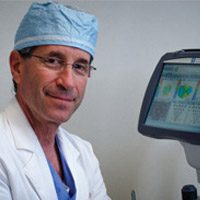Though we knew little about the new OPD-Scan III, I’m very glad we were able to experience all of the advantages of the new device. I’ve been very happy with it for numerous reasons, the most important being that the information it provides has helped dramatically in determining which IOLs are best for our patients. We have a much better idea, for example, who will have satisfying outcomes with multifocal lenses.
Group: OPD-Scan III Wavefront Aberrometer
Toby Tyson, MD
One of my patients had IOL calculations that reflected a lot of cylinder. This would have been a toric patient, but as soon as I saw my OPD III printout, the top showed me this very interesting asymmetric astigmatism. It looked like a “C” right in the middle of the cornea. It happened to be the perfect size for a Goldmann tonometer, so the OPD III was able to pick it up. If I hadn’t seen that, I would have operated on this patient and put in the wrong lens. Luckily, the OPD III showed me what was going on, so I was able to bring the patient back on a later date, get the right IOL Master measurements, and perform the correct surgical procedure.
Paolo Vinciguerra, MD
You’re getting this in a single instrument, not multiple instruments. Without the OPD-Scan III, you have to use a topographer, move the patient to the aberrometer, and then move the patient again to do pupillometry. With the OPD III, you get everything in one shot with perfect registration, so you see exactly what the curve is, and you see the interior-internal-posterior dimension in the same location
Richard Tipperman, MD
Jonathan H. Talamo, MD
We wanted something that would combine and automate testing in an inline fashion that allowed comparisons between important aspects of the refractive and anatomic states of the eye. It also had to be quick and efficient to use so we could screen every patient who came into the practice. The OPD-Scan III fulfills those needs.
Kerry Solomon, MD
I purchased the OPD because I wanted to have a number of diagnostic devices and wanted to find a way to have it presented in a fairly efficient manner. For me it provides an autorefraction, a wavefront refraction, a topography, and lets me look at high order aberrations of the eye and cornea all under one setting.
Jonathan Solomon, MD
The OPD-Scan III helps me reach a goal of zero spherical aberration with my cataract patients. A few years ago, I studied how accurately and predictably dynamic skiascopy, the wavefront technology used measures spherical aberrations and guides IOL choice. When I chose from three different IOLs based on data from the device, postoperative spherical aberration for 40 patients was just +0.019±0.051 μm. When we can virtually eliminate spherical aberration for our cataract patients, we increase patient satisfaction. In particular, when patients have other visual problems that we can’t correct, even a relatively small change, such as reducing nighttime glare, can make a big difference in their lives.
Larry Patterson, MD
The reason I got the OPD to begin with, we were having a lot of people who we put multi-focal implants in, and most of them were happy but a sizable minority were unhappy. And I learned later that part of that reason is that some of these people who are unhappy had some problems with their eye that we weren’t picking up. It might be a large angle kappa, it might be corneal coma, it might be dry eyes. And my original reason for buying the OPD was to help me with those patients. With a very quick OPD scan, I’m getting exactly what their mesopic and photopic pupils are. I can see what the angle kappa is, I know their spherical aberrations, their corneal coma. We have a beautiful scan where I can see their placido rings on the cornea, it gives us an idea of how much dry eye there is. There is a lot more information and you can see it all on one sheet. It’s really helpful. We probably do fewer multi-focals than we used to, but we have happier patients now.
Richard Prince, MD
The Marco OPD-Scan III is very useful – if you do a lot of refractive cataract surgery you can’t live without it. We use it pre-op on all patients and I look at spherical aberration, topography, K’s, angle kappa, etc. Shame one cannot get reimbursed for its use mostly, but we love it! For toric and multi-focal IOLs it’s an absolute MUST HAVE. The training by Marco is also secondary to none. We just bought our second OPD.
Marguerite McDonald, MD
The OPD-Scan III is a great way to check your surgical technique post-operatively and one of the most common post op problems, whether its LASIK or PRK, is dry eye. You can show a patient, on the OPD, that they are perfectly centered, no prescription but you see all these little speckles? That means your eye is bone dry and it is ruining your optics. You can also subtract out corneal aberrations from the whole eye aberrations so you can find out if there is an early cataract that is going to make a 50 year old patient unhappy after a LASIK procedure. The OPD is such an invaluable tool – being able to sort that out; it educates me and it educates the patient and that maybe we should be talking about a refractive lens exchange instead.










